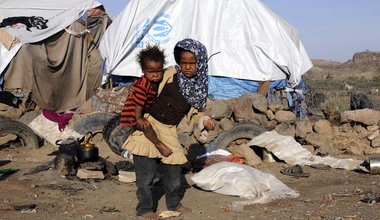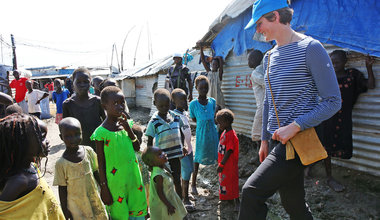UN refugee agency urges better measures for people crossing contact line in eastern Ukraine
 The United Nations refugee agency today called on authorities in Ukraine to help ease the plight of some 26,000 people who cross the dividing line between Government-controlled and non-Government-controlled areas of the crisis-gripped country daily.
The United Nations refugee agency today called on authorities in Ukraine to help ease the plight of some 26,000 people who cross the dividing line between Government-controlled and non-Government-controlled areas of the crisis-gripped country daily.
“Despite the ceasefire agreed in 2015, the security situation in eastern Ukraine remains tense and volatile. Flare-ups of hostilities continue, and people waiting to cross the contact line risk being harmed by shelling or the presence of landmines and explosive remnants of war,” said William Spindler, the spokesperson for the Office of the UN High Commissioner for Refugees (UNHCR), at the bi-weekly press briefing in Geneva.
“They face exhausting and often abusive procedures, including having to wait long hours in line to cross to see their relatives, purchase goods and medicines or resolve documentation issues in order to get their pensions and benefits,” he added.
Mr. Spindler emphasized that such extraordinary restrictions on movement in eastern Ukraine, now in their second year, have created “increasingly alarming hardships” and limited the access of thousands of people, including the elderly, to health care and social payments.
The long lines remain the biggest concern of people crossing the line of contact, who must go through lengthy document and security checks by a limited number of personnel. More than half of those travelling by car say it is almost impossible to complete the formalities in one day and that they have had to stay overnight at least once at a crossing point, according to the spokesperson.
A UNHCR survey found that one in four people trying to cross are in the category of “extremely vulnerable individuals” – those with disabilities, the elderly, persons with a severe medical condition, and women, often travelling alone and accompanied by children. The agency also observed an elderly couple who spent 7 hours on their feet waiting for the bus to transport them to their relatives.
“People line up to cross with no adequate waiting facilities, such as shelter from rain or sun and there is no emergency medical support. Several deaths were reported at the height of the summer and the situation is certain to be more alarming, come winter. There is a lack of sufficient water and sanitation facilities for the people in lines,” Mr. Spindler said.
Based on the monitoring results, UNHCR this summer installed weather shelters to protect people from rain and sun at all open crossing points in eastern Ukraine.
“Our teams are working to provide transport solutions for the remote communities on both sides affected by the ongoing conflict,” the spokesperson said.
Many communities have been left isolated as regular transport connections were halted because of shelling. Mr. Spindler stressed that there is an urgent need for bus lines to ensure travel across the line of contact for vulnerable persons, who make up more than 40 per cent of those crossing.
During the UNHCR survey people also raised concerns regarding alleged checkpoint corruption and checkpoints closures on multiple occasions due to shelling. Many are not informed about regulations related to crossing the line of contact and documentation required, the spokesperson said.
Moreover, non-recognition of documents issued by de-facto authorities in non-Government controlled areas prevents crossing of children to Government-controlled areas. Several cases were reported when children were denied crossing to the non-Government-controlled areas when they were accompanied by only one parent, according to the spokesperson.
“UNHCR calls on authorities to facilitate and simplify the procedures at the crossing points. Authorities need to ensure more registration booths, having cameras installed to prevent abusive practices, having female staff on duty at all check points,” Mr. Spindler said.
He added that UNHCR is working on a package of measures to improve the situation and fasten the procedure, and is planning to have a bus line for vulnerable people to cross the contact line with fewer obstacles on both sides.
More than 9,300 people have been killed in Ukraine since the beginning of the separatist conflict in eastern regions of the country in mid-April 2014.
While the rate of casualties has slowed substantially since a ceasefire in September 2015 and the signing of the Minsk Peace Accords – an agreement signed under the auspices of the Organization for Security and Co-operation in Europe (OSCE) to halt fighting in the Donbass region of Ukraine – some 10 people are still killed each month, according to the Office of the UN High Commissioner for Human Rights (OHCHR).
In late February 2014, the situation in Ukraine transcended what was initially seen as an internal Ukrainian political crisis into violent clashes in parts of the country, later reaching full-scale conflict in the east. Nevertheless, despite the ceasefire agreed in Minsk, the situation has since deteriorated, with serious consequences for the country’s unity, territorial integrity and stability.
 UN
UN








